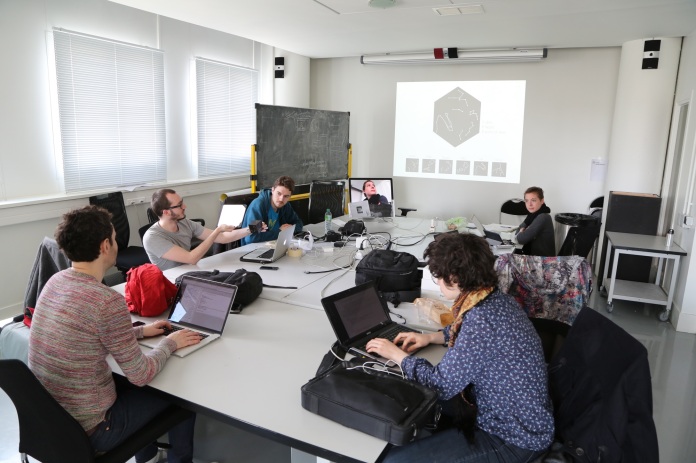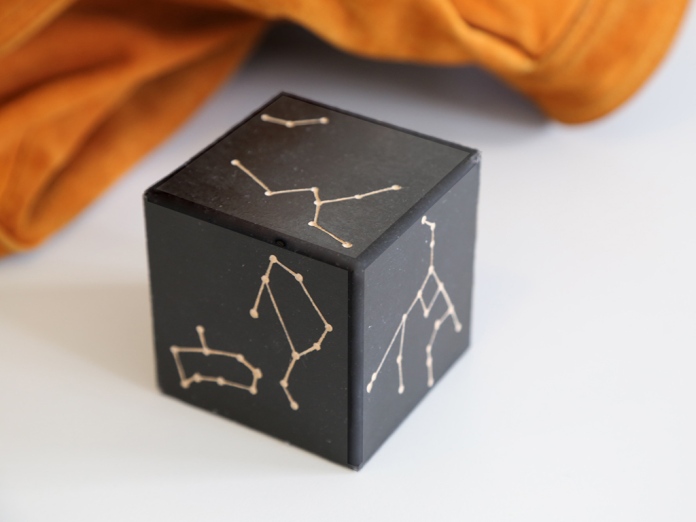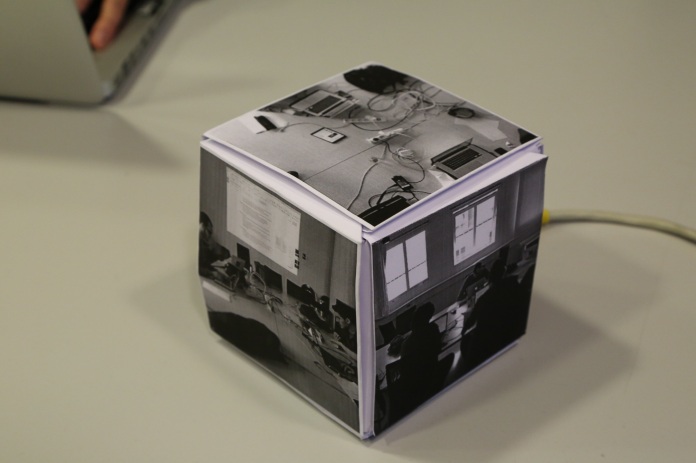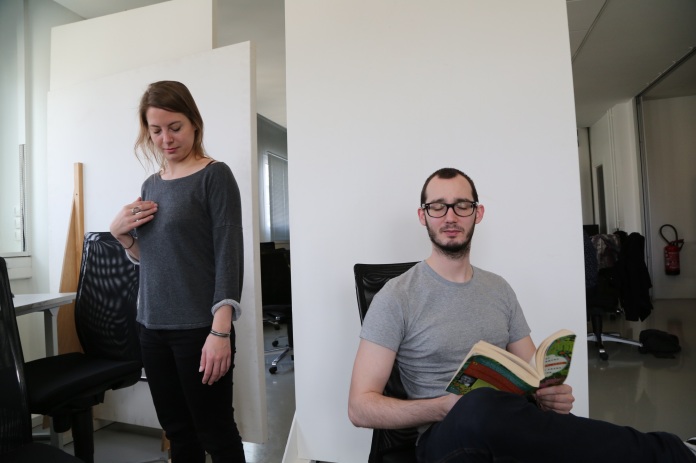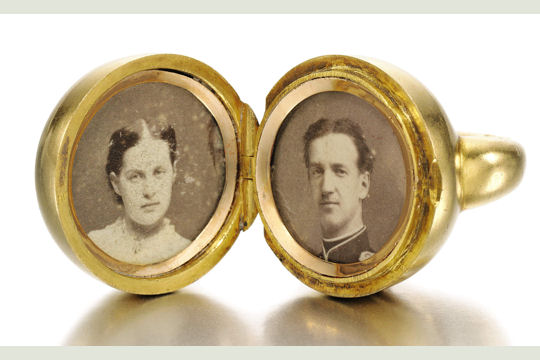Month: May 2014
Protected: Course on design fiction 2014, how to balance?
Protected: Course on design fiction 2014, how to provoke reactions?
Protected: Course on design fiction 2014, how to switch to fiction?
Telepresence Workshop end
We presented to our design supervisor Remy Bourganel the results of this workshop session. All the projects need a lot more work but it was a good step forward in my research to observe others working with the design principles I proposed – Our design choices aim at producing an uncanny enough feeling to engage the audience in a reflective process, by making the project:
– legible
– probable
– familiar but not too much
– unfamiliar but not too much
(There will be more criteria when working on the communication of these projects).
Remy asked (and saw) why a part of the project where not considerable as speculative design. Our feedback: actually it is not simple to turn a designer into a “critical designer”, depending on the context they sometime needs to gain confidence by practicing classic design first. Reflecting on the design fiction course I also give, I think the method to unlock designers mind to the “critical mode” was not ready this time.
Remy challenged us on the uncanny part as it does not look uncanny enough for him. Indeed we need to push the projects further by doing “audience-testing”.
Outcomes:
• observing negotiation strategies in the design process (uncanny balance)
• producing a different kind of project, the aesthetic is more like “bleecker’s design fiction”: centered on optimistic solution and everyday-life objets (it is less “RCA white cube gallery’s critical design” aesthetic which is sometimes cynical.
• It was very hard to make the team shift to a “what if” methodology, my method was not good enough
Next step:
• Design the staging & the user scenarios (to tune the uncanny)
• Evaluate the uncanny criteria
Here are the slides.
Telepresence workshop, Time Frame
TimeFrame – delayed skype to resynchronise your day time when living in two far countries.  Narrative image that shows the project in use – has to be completed by another visual/diagram that explains the concept
Narrative image that shows the project in use – has to be completed by another visual/diagram that explains the concept  Interface of the frame that is in – You can notice the choice we made to show the both videos: the delayed one and the real-time one. This choice will have to be tuned after having conducted first “audience-tests”. Our design choices aim at producing an uncanny enough feeling to engage the audience in a reflective process.
Interface of the frame that is in – You can notice the choice we made to show the both videos: the delayed one and the real-time one. This choice will have to be tuned after having conducted first “audience-tests”. Our design choices aim at producing an uncanny enough feeling to engage the audience in a reflective process.

Interface of the frame that is in Montreal – To be noticed, these are first tries produced during the workshop session. They will be redesigned, avoiding the “skype-like” aesthetic. Indeed, users would not stare at the frame all the time if it was always on. 

[youtube https://www.youtube.com/watch?v=wP9Gk8ild1o&w=853&h=480]
Photo shoot we made to prepare a video on the project (+ and extract of the video) – coming later The project that had the most potential is Time Frame. We think this because the societal issues it highlights are complexly mixed between desire and repulsion.
TimeFrame is a delayed skype that resynchronises your day time when living in two far countries
Abstract: what if you could wake up and go to bed together again. It has been 6 month that your lover lives in an other country and despite skype and the mobile phone efficiency you will never have this opportunity – except using Time Frame. It is a simple delayed skype-like video that resynchronises your day time. This “augmented photo frame” only has to be set once – enter your close one I.P. and it will set the video time-delay for you.
Issues: illusion of presence. Real need VS fake solution; living together VS unable to talk
First user reactions: (from our tester that leaves in Montreal)

Telepresence workshop, Omnidice
[youtube https://www.youtube.com/watch?v=JQOyZmGe3Zs&w=640&h=480]
Here is the final document we made during the workshop to communicate the project – more work to be done soon
Abstract: The project proposes an omniscient access to 6 peripheral vies of one conference room or appartment room. You can switch between views on an mobile phone app by moving a cube (using augmented reality).
Issues: not really a critical design project, except if used in the home, we can see the issue of surveillance, again, like often.
These issues are connected to my topic of the feeling of absence/presence, but not directly, therefore we did not spend to much time on it during the workshop session, we will come back to it later.
Telepresence workshop, Photostill
Here is the final shoot we made for the workshop – waiting for more work to be done soon on the interface, and the communication of the project.
We decided to change the name from Photo-steal to photostill as it stresses less the problematic of privacy (which is already enough present) – we tried to make it not too much uncanny.
Abstract: The project proposes an intimate access to one close friend / lover. You can view what your friend sees, or at least a glimpse of the environment he’s involving into.
Issues: the project mainly highlight the issue of privacy VS mutual confidence; but also voyeurism, surveillance, etc.
These issues are connected to my topic of the feeling of absence/presence, but not directly, therefore we did not spend to much time on it during the workshop session, we will come back to it later.
Telepresence workshop, Time Frame (work in progress)
TimeFrame – delayed skype to resynchronise your day time when living in two far countries.
Abstract: what if you could wake up and go to bed together again. It has been 6 month that your lover lives in an other country and despite skype and the mobile phone efficiency you will never have this opportunity – except using Time Frame. It is a simple delayed skype-like video that resynchronises your day time. This “augmented photo frame” only has to be set once – enter your close one I.P. and it will set the video time-delay for you.
Issues: illusion of presence. Real need VS fake solution; living together VS unable to talk
Work in progress

Looking for code solutions to delay video streaming – we did finally not focus on the working prototype part of the project for the moment. It will come later.

Looking for design shapes for the TimeFrame product – we started from many possibilities but decided that a simple photo frame would seems more familiar. It is important as the product service can create repulsion, we had to balance the “uncanny” effect.

Testing different visual rendering for the video – we had to choose how would the video look like in the frame. We finally decided to keep the most familiar aesthetic for the product. But this could change after our first “audience-tests” (my appellation for first tests of showing the project to an audience, like a “user-test” with an audience).

Designing the service, deciding how the delay work.
Is the camera always running? Is there many frames in one house? Can the user control the delay (to cancel it)? These are a selection among the questions we asked ourselves. We made our choices according to the criteria we proposed in our paper(1). This criteria were proposed to the team later in the design process because it was too much to think about from the beginning. We therefore focused on our aim: engaging the audience into a reflective state.
(Top left) A technical diagram for ourselves to understand the delay to introduce on each frames
(Bottom left) A proposition of diagram to make the concept more legible.
(Bottom) Beginning of some user scenarios + references we evoked
(1) Mollon, M., & Gentes, A. (2014). The Rhetoric of Design for Debate: triggering conversation with an “uncanny enough” artefact (pp. 1–13). Presented at the Proceedings of the Design Research Society International Consortium (DRS), Umeå, Sweden.

Some circular shape tests for the design of the frame – rapidly abandoned.
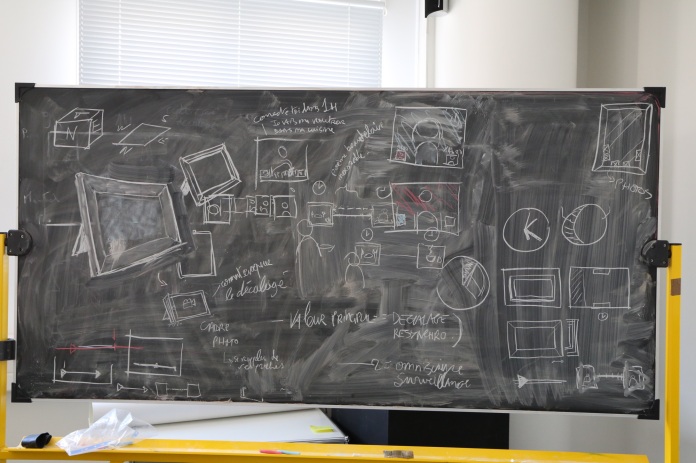
Different shape researches, technical diagram for making it, etc. (Middle right) Working on a special clock to indicate two different times. (To right) Questioning the size of the frame/screen, we were evoking the big mirrors were people place pictures between the frame and the mirror.
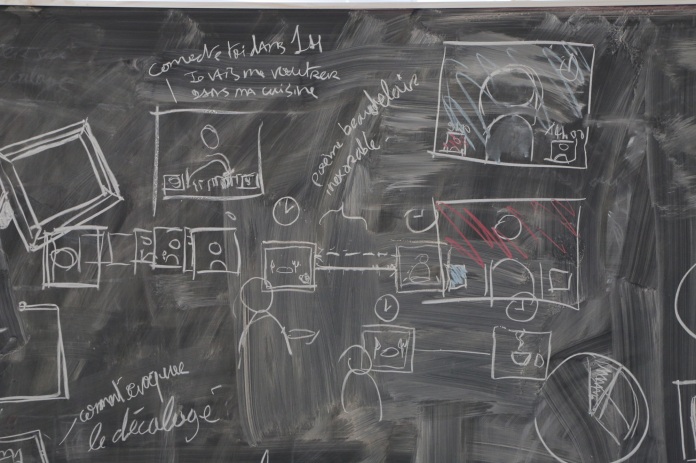
Working on the digital interface to make it legible (visual affordances) + some written catch phrase (in french), inspirations for future user scenarios.

As choices had to be precisely tuned sometimes, and as debates sparked in the team on different design choices to be made, we decided to write down the brief of our project. User need, use scenarios, values to communicate (synchronisation, living together again…), etc.
Telepresence Workshop, PhotoStill (Work in progress)
We finally focus on three projects that have the potential to become speculative designs. Here is the work in progress summary for Photo Steal – steal pictures from the mobile-phone camera of a close friend.
Abstract: The project proposes an intimate access to one close friend / lover. You can view what your friend sees, or at least a glimpse of the environment he’s involving into.
Issues: the project mainly highlight the issue of privacy VS mutual confidence; but also voyeurism, surveillance, etc.
These issues are connected to my topic of the feeling of absence/presence, but not directly, therefore we did not spend to much time on it during the workshop session, we will come back to it later.
Work in progress
The team split in two for:
– making a working prototype on a mobile phone
– designing a specific object
The prototype on the mobile is an hack on a android: when you send an email with a specific object to a specific email address you receive a picture taken from the phone wherever it is. The pictures taken are often not pointing at anything, of are taken in a trousers pocket. However, after a couple of days of use the phone owner began to set mini-staging for his phone to take intentional situations from time to time (hi working, a flower, etc.)
The aesthetic of these small pictures where quite touching, intimate, etc. but the mobile phone did not correspond to the feeling we wanted to communicate with the project. We began brainstorming on the different objects we could designs to accomplish this function. That is when I proposed the notion of uncanny (see slides) as a design principle or as a constraint to respect in order to stimulate people attention. The aim is to being the audience into a reflective state on our problematics.
Here is the different propositions we made (left to right) a kind of ipad lens (bottom); a neck lace/medaillon; a little private locked note-book, a round shape mirror; a mobile sculpture; a pensieve (water mirror dream catcher). The aim was to choose the one that could stimulate people interest and reaction [Edit: I realise later that these implicit criteria were the one from my paper: probability, legibility and uncanny (familiarity/unfamiliarity)].

